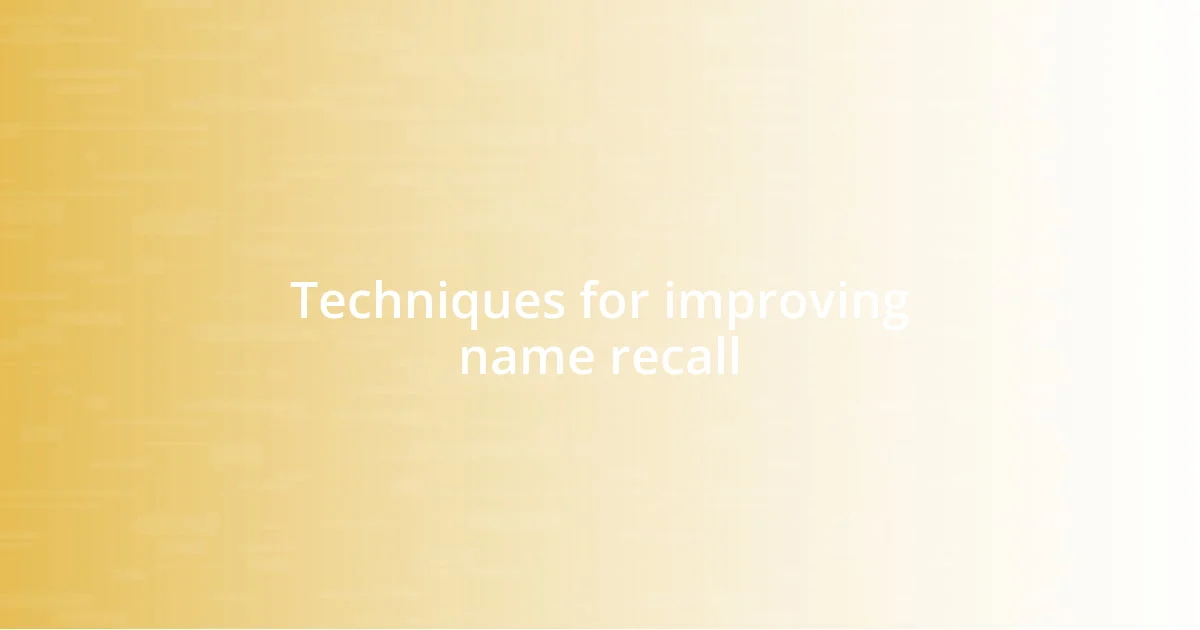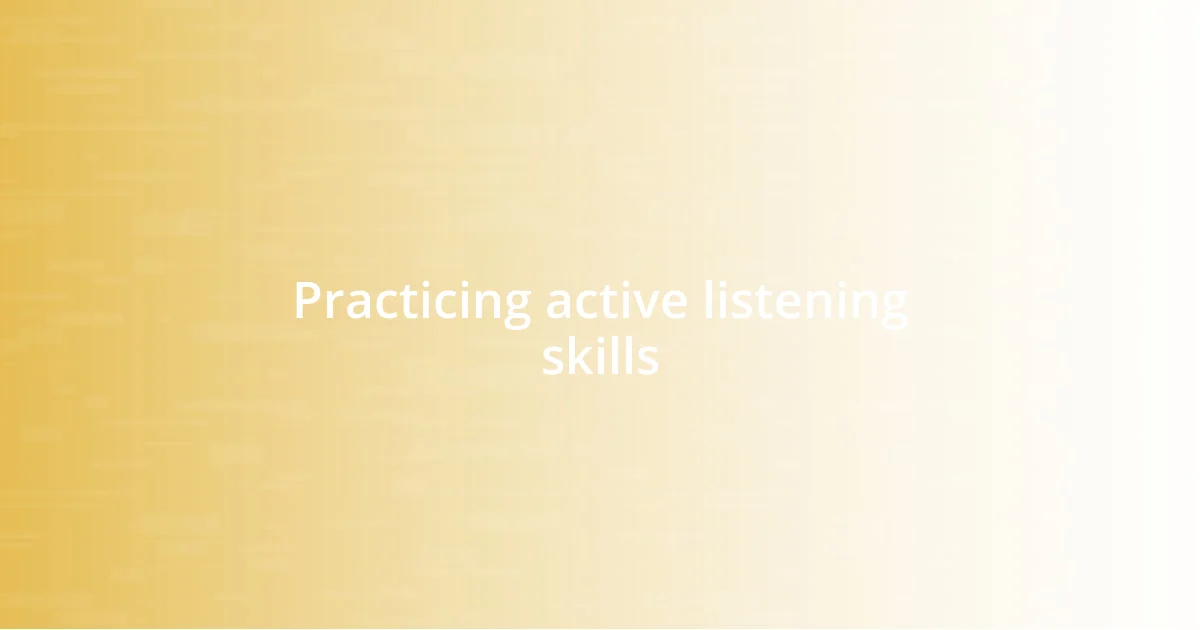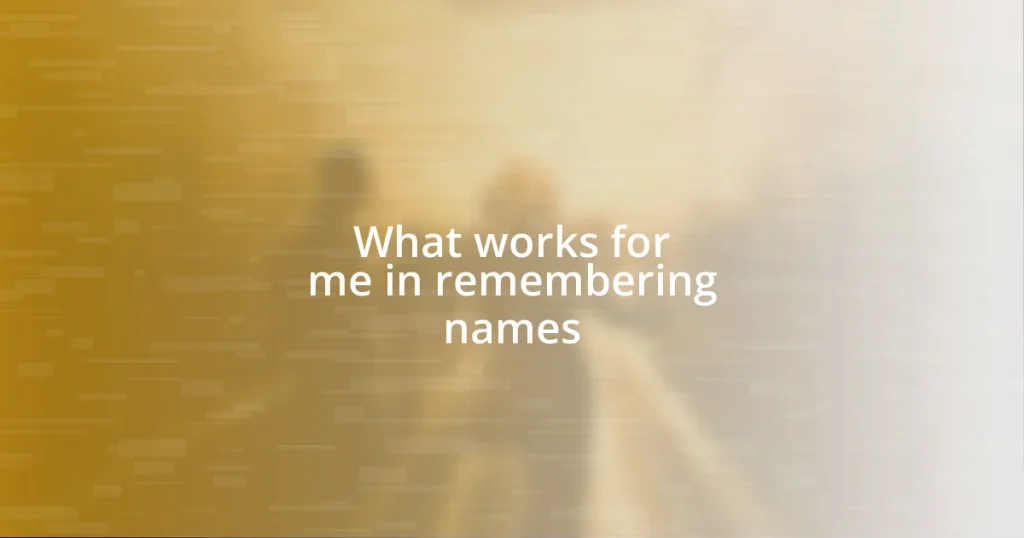Key takeaways:
- Names foster emotional connections and reflect personal stories, highlighting their significance in relationships.
- Common challenges in remembering names include distractions, short-term memory overload, and lack of repetition.
- Techniques for improving name recall include mental imagery, repetition during introductions, note-taking, and practicing active listening.

Understanding the importance of names
Names hold a profound significance that often goes beyond mere labels. I remember a time when I met someone named Sarah at a networking event. Later that evening, I found myself thinking about our conversation, and her name resonated with me, making me feel a sense of connection that I might not have experienced otherwise. It’s fascinating how just saying someone’s name can foster a sense of belonging.
Have you ever noticed how a name can elicit memories or emotions? For instance, there’s something warm and familiar about the name “Eddie” for me—it reminds me of my childhood friend who always made me laugh. When names evoke such nostalgia, they create emotional bonds, shaping how we perceive relationships. This connection emphasizes why remembering names can be crucial in both personal and professional settings.
Moreover, names can carry cultural or familial significance, connecting individuals to heritage and lineage. I often think about how names can reflect someone’s story, their background, and even their aspirations. When we take the time to remember a name, we honor that story and, in a way, acknowledge the individuality of each person we meet. Isn’t it powerful to think of names as portals into someone’s unique experiences?

Common challenges in remembering names
One significant challenge I often face in remembering names is the pressure of the moment. When I’m introduced to someone new, my mind sometimes races with thoughts about what to say next or how to make a good impression. This internal chatter makes it easy to forget the person’s name almost immediately. I’ve even caught myself nodding along during introductions while my brain scrambles to handle social jitters.
Here are a few common challenges people encounter when trying to remember names:
- Distraction: It’s tough to focus on the conversation and the name when there are so many other stimuli around us.
- Short-term memory overload: New information can quickly get lost if it’s not reinforced right away.
- Similar names: Sometimes, meeting multiple people with similar-sounding names can create confusion, leaving me second-guessing who’s who.
- Lack of repetition: Without saying the name a few times, it slips from memory faster than I anticipated.
Reflecting back on past experiences, I realize that facing these challenges often leads to an inner sense of frustration. The effort to remember names, when thwarted, can feel like a missed opportunity for connection.

Techniques for improving name recall
When it comes to improving name recall, I’ve found a few techniques that consistently work for me. One of my favorites is creating a mental image associated with the name. For instance, the name “Rose” reminds me of a beautiful flower garden I visited last summer. Visualizing this connection aids my memory and adds an emotional layer to the name, making it easier to recall later.
Another technique that I’ve incorporated is repeating the name back during the introduction. When I met a colleague named “Jason,” I’d say something like, “Great to meet you, Jason!” This not only reinforces my memory but also makes the interaction feel more personal and engaged. I’ve noticed that when I actively use the name in conversation, it sticks much better.
Finally, I make it a habit to jot down names and any key details about the person when I can. At a recent conference, I took a moment after each session to write down the names of individuals I’d connected with, along with a fun fact about them. This simple act has transformed how I remember names, creating a tangible reference point that I can revisit, ensuring that those connections remain fresh in my mind.
| Technique | Description |
|---|---|
| Mental Imagery | Creating a vivid image linked to the person’s name. |
| Name Repetition | Repeating the name during introductions to reinforce memory. |
| Note-taking | Jotting down names and details for later reference. |

Using visualization for name retention
One visualization technique that works exceptionally well for me is linking names to vivid images that have personal significance. For example, I remember meeting a person named “Sky,” and immediately, I pictured a clear blue sky on a sunny day. Every time I think of their name, that serene image pops into my mind, ensuring I don’t forget it. Isn’t it fascinating how our brains can latch onto such images to aid memory?
I’ve also started to visualize something quirky or exaggerated about a person when I first learn their name. When I was introduced to an artist named “Drew,” I imagined a giant paintbrush in his hand, creating an enormous mural. This funny mental picture turns an ordinary name into something memorable and entertaining, transforming a simple introduction into a more engaging experience for me. Have you ever tried adding a touch of humor to your memory tools?
Incorporating colors or symbols can also strengthen these visualizations. For instance, thinking of the name “Amber,” I visualize a warm, glowing amber stone. This technique not only enhances the retention of the name but evokes a pleasant feeling associated with it. The warmth of the image makes me feel connected to the person, reinforcing how I remember their name and the interaction we had. It’s interesting to reflect on how these imaginative connections can make the challenge of remembering names a little less daunting, don’t you think?

Practicing active listening skills
Active listening has been a game-changer in my journey to remember names. When I truly focus on what someone is saying, I find that their name sticks with me far better. I remember attending a networking event where I made it a point to listen intently to each introduction. By absorbing not just the name, but the context and emotional nuances behind it, I felt more connected to each person and their story. Have you ever tried really tuning into someone’s words rather than thinking about what you’ll say next? It’s eye-opening.
One powerful strategy I’ve adopted involves reflecting back on what I hear. For instance, when someone introduces themselves, I’ll often echo some key details. This can be as simple as saying, “Nice to meet you, Sarah, and I hear you’re into photography!” This not only reinforces their name in my memory but shows that I value their identity. I’ve noticed during conversations how the shared experience of remembering together creates a bond that enhances both my recollection and the quality of our interaction.
I’ve also found that practicing active listening goes hand in hand with emotional engagement. When I connect with someone on a deeper level, their name becomes a part of my memory tapestry. I recall a moment when someone shared a heartfelt story about their family. Their name, “Maria,” became etched in my memory not only because I paid attention, but because that emotional sharing made it significant to me. It’s fascinating how emotions can anchor our memories; is it any wonder that we remember personal connections so vividly?

Social strategies for remembering names
Engaging socially can truly aid in remembering names. I remember a time at a community gathering where I made it a point to smile and greet everyone warmly, repeating their names in my mind. When I introduced myself to a woman named “Lily,” I made sure to say, “Hi, Lily, it’s great to meet you!” The way I saw her face light up when I used her name helped lock it in my memory. Hasn’t using someone’s name in conversation always felt a bit like a secret ingredient in building rapport?
Another strategy that often escapes people is associating names with unique traits or hobbies. At a recent workshop, I met a man named “Bob,” who mentioned his love for sailing. I instantly thought of a bobbing boat on serene waters. By picturing him with a captain’s hat and navigating through the waves in my mind, it not only made his name stick but also added a delightful image that I look back on fondly. Isn’t it amusing how enriching someone’s identity with a visual can make all the difference?
Lastly, I’ve discovered the magic of repetition in social contexts. During a team lunch, I made an effort to incorporate my colleagues’ names into our conversations, like saying, “What do you think about this, Tom?” I found that each mention strengthened my recollection, transforming mere names into familiar faces and voices over time. It’s as if every name tossed into the mix becomes a thread in the tapestry of relationships I am weaving. How have you used conversations to strengthen your memory of people?

Review and reinforce learned names
Reviewing and reinforcing learned names is crucial for solidifying those connections in my mind. After meeting someone new, I often take a moment to mentally recap our interaction. For instance, I might think, “I met David, and he works in marketing at a tech company.” It’s that quick recap that transforms a fleeting encounter into a lasting memory. Have you ever noticed how this simple step can make a world of difference in recalling names later?
I’ve also created a habit of jotting down names in a small notebook after events. This practice has become a little ritual for me. Reflecting on my interactions, like noting “Sarah loves hiking,” not only reinforces the name but also connects it to a detail that makes her unique. Isn’t it interesting how those little facts can turn a name into a person in our mind? My notebook has become a treasure trove of these moments, allowing me to reflect on meaningful conversations.
Additionally, I frequently revisit these names through casual conversation or even in my thoughts throughout the day. If I know I’ll be seeing certain people again, I’ll mentally rehearse their names and once again link them to their faces and stories. Just recently, I did this with a colleague named “Emma,” reminding myself of her role in our last project. In doing so, I not only cemented her name in my memory, but I also felt closer to her as a collaborator. Isn’t it satisfying when effort leads to such personal connection?















